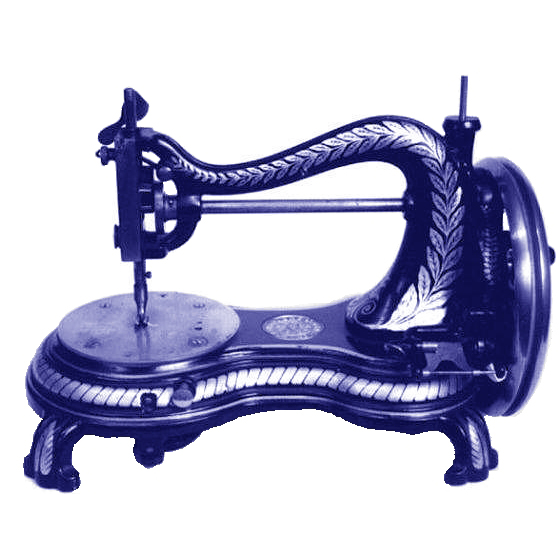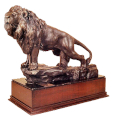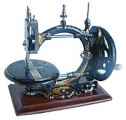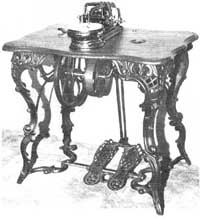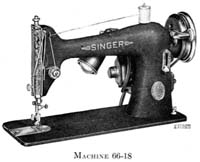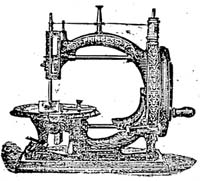Bachelder's Patent
PERHAPS THE MOST valuable sewing-machine patent of all was not Howe's eye-pointed needle, or Wilson's four-motion feed, but an 1849 invention of John Bachelder.
This important merchant took out a patent for a strange device with an endless belt, supported on rollers, which fed the cloth beneath the needle. What Bachelder didn't realise -- but Singer's lawyers who bought the invention from him did -- was that the patent covered using any form of horizontal surface to support the cloth being stitched.
Therefore, any machine with a stitch plate had to pay over to the Bachelder patent.
It was this patent which provided Singer's entry to the Sewing-Machine Combination which with Howe, Grover & Baker and Wheeler and Wilson controlled sewing-machine manufacture in the USA from 1856 to 1877.
At the time Howe's first machine was on exhibition in 1847, Bachelder was running his import business in Milk Street, Boston -- not far from the corner of Howard and Court Streets where the new sewing contraption was drawing vast crowds.
Bachelder passed the corner twice a day, going to and from work, and became so interested that he examined the model and, despite being no engineer, quickly decided that he could improve upon it.
He fitted up a room in his home as a workshop, gave up the importing business, and devoted himself full time to his sewing machine.
He produced a patent model which was certainly much more of a sewing machine than the Howe toy, but like Elias he had trouble getting any industrialists interested.
In fact he did better than Howe and three machines were eventually placed in tailoring business in Boston. Pretty soon trouble sprung up with the workers threatening to walk out if the machines were not dispensed with.
Two of the firms gave in without much of a struggle but the third, although agreeing to remove the machine, set it up secretly in the home of one of the outworkers for doing fine stitching on satin waistcoats. But the style of the stitch gave the game away and this machine, too, had to be dumped.
After five years of struggle, with all his money gone, the Singer lawyers who knocked at his door waving $4000 were almost welcome. He sold them the patent and in doing so gave away a fortune. For the Bachelder patent was the cornerstone of the Combination's monopoly.
First the patent was extended by the Patent Office in 1863 for a second seven years and then by special act of Congress -- I wonder what strings Singer pulled to get that past the government -- until it finally expired in 1877.
With all of its extensions, the Bachelder patent was the last big gun left in the Combination's amoury and on May 8, 1877, the day the patent expired, the most powerful monopoly in the history of the USA announced its closure.
Just what the end of the patent protection would mean to the sewing-machine business was best shown by Singer who, on that May day, slashed the prices of machines by 50 per cent in order to compete in what was now wide open, free, competition.
For the last 10 years of its existence the Combination had relied on the Bachelder patent alone, and yet in that period it is known that one company had paid them nearly one million dollars in royalties.
The New York Times (all the news that's fit to print) did its own estimate of how much had been paid for the privilege of producing a sewing machine with a stitch plate. The paper guessed that license fees would have topped four million dollars.
Bachelder lived to the age of 89, dying at the home of his daughter in Michigan after a fall. It is believed that he reaped some benefits when the patents were renewed and certainly did not die in poverty.
